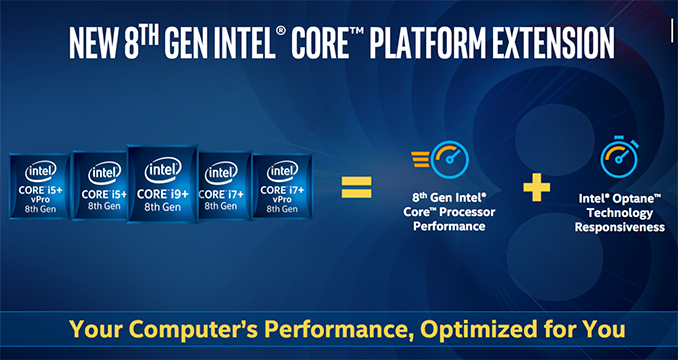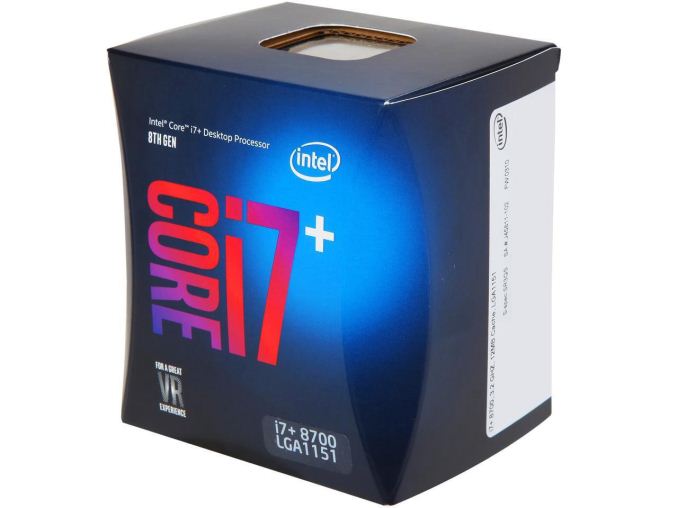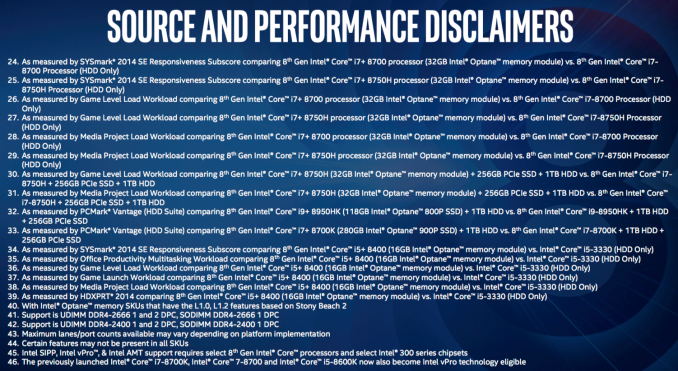Intel’s Core i5+, Core i7+ CPUs with Bundled Optane Memory Hit Retail
by Anton Shilov on April 12, 2018 5:30 PM EST
Earlier this month Intel introduced its Core i+ processor brand for desktops and laptops. The brand-within-a-brand setup sees Intel's 8th gen Core i5, i7, and i9 CPUs bundled with its Optane caching SSDs (aka Optane Memory) and sold as the i5+, i7+, and i9+ respectively. The chip giant aims such CPUs at customers who would like to improve performance of their storage subsystems yet won't be investing in full-fledged SSDs. And, after showing up in OEM systems with last week's launch, the Core i+ processors are now also to retail buyers.
Overall, Intel is rolling out the Core i+ in retail, targeting DIY end-users in the U.S., Canada, and Japan. The lineup of Intel’s Core+ CPUs for desktops currently consists of three SKUs: the Core i7+8700, the Core i5+8500 and the Core i5+8400. The bundles include 16 GB Optane caching drives and are priced at $340, $240 and $215, respectively. For mobile computers, Intel is also offering Core i9+ processor bundles, but it remains to be seen whether the company also plans to expand the family of its Optane-bundled offerings for desktops.
| Intel Core i5+ and Core i7+ CPUs with Bundled Optane Memory for Desktops | |||||
| Price with 16 GB Optane | Price of CPU only | PN | |||
| Core i7+8700 | $340 | $302 | BO80684I78700 | ||
| Core i5+8500 | $240 | $205 | BO80684I58500 | ||
| Core i5+8400 | $215 | $179 | BO80684I58400 | ||
With its Optane Memory products, Intel is attempting to kill two birds with one stone. Firstly, the company is capitalizing on demand for high-performance/high-capacity storage subsystems that combine responsiveness of SSDs and capacities of HDDs. Secondly, the company is ramping up production of its 3D XPoint memory and gaining experience in its high-volume manufacturing (i.e., improving yields), something that it is going to need to address needs of datacenter and enterprise market segments going forward.
This increased focus on selling lower capacity Optane modules for caching comes as Intel has made some notable changes to their caching subsystem to improve its usefulness. The Optane software can now cache data from any HDD (not just the primary/boot one), opening up interesting usage scenarios with secondary HDDs for end-users who have already invested in a SSD for their boot drive.
Intel says that a hybrid storage subsystem accelerated by a 32 GB Optane caching SSD is 1.7 – 3.9 times faster when compared to a non-accelerated HDD-based subsystem (see the slides below for details). The performance boost only occurs in situations when cached data is used, so a caching SSD is not a replacement for a regular SSD. However, it is considerably cheaper and since it does improve user experience, it makes the Core i+ bundles particularly useful for PC makers.
Last year Intel teamed up with select makers of motherboards to bundle its Optane caching SSDs with their platforms. This year the company is shifting its strategy and intends to sell such drives with its CPUs.
Related Reading:
- The Intel Optane Memory (SSD) Preview: 32GB of Kaby Lake Caching
- The Intel Optane SSD 800p (58GB & 118GB) Review: Almost The Right Size
- The Intel Optane SSD 900p 480GB Review: Diving Deeper Into 3D XPoint
Sources: TechReport, Tom’s Hardware













42 Comments
View All Comments
Drumsticks - Thursday, April 12, 2018 - link
Not necessarily. There are certainly use cases where people have a relatively small SSD to run the OS and a bigger HDD for bulk storage, possibly even games or other programs. I'm all flash now, but I had such a setup for a few years when I couldn't afford bigger SSDs. You already have most of the benefit of having your OS on an SSD, but now you can accelerate the majority of your storage at a time as well.AdmrlAhab - Thursday, April 12, 2018 - link
That's true, but I'm 99.9% positive that Optane drivea can't be used as boot devices.Ryan Smith - Friday, April 13, 2018 - link
The small ones can't by virtue of being so small. But the larger 800p series and above can be used as boot drives.MattTheTechLV - Friday, April 13, 2018 - link
It can't be used as the boot drive, but it CAN be used to ACCELERATE or CACHE the boot drive. Up until now, it's only been available for that, and I have come acrossed it once or twice in the wild, it does a surprisingly good job, but I thought it was disappointing that I couldn't use it for clients who already had an SSD for the boot drive, but had a secondary storage drive that was often accessed that I couldn't use it for. Now I can. I would still prefer an 850/950 Evo for most clients, but in the case where that isn't in the budget, and their system happened to be a 7th or 8th Gen Intel, I would definitely consider it. I don't know if these bundles will be particularly helpful, but time will tell I guess. Of course for my own systems it will be hard to use these, Ryzen is not compatible obviously...edzieba - Friday, April 13, 2018 - link
All Optane drives (m.2 or PCIe or u.2) present themselves as any other NAND-based NVME SSD, and can be used as such on any platform that supports that. You only get the caching feature with an Intel chipset, but if you wanted you could put an Optane 'cache' drive and boot Linux off of it on a Ryzen platform, and it would work just fine.Phyzzi - Friday, April 13, 2018 - link
Huh. Better stop booting from my 1 TB optane drive then...Not sure why you included such a high statistical probability for something you obviously didn't fact check at all. Maybe you meant you can't boot from the integrated ones? You still seem very sure of something that you provide no evidence for.
rarson - Monday, April 16, 2018 - link
1TB Optane drive, huh? Is your computer imaginary?beginner99 - Friday, April 13, 2018 - link
I still have my game son some crappy 5400 rpm drives and I don't care much. Optane would not help here because it's too small, could cache barley 2 games.iter - Friday, April 13, 2018 - link
Actually many modern games exceed 32 gigs. And they keep growing rapidly.In fact, over 150 of the games released the last couple of years exceed 32 gb in installer form, so they are even bigger when installed.
Hypetane as cache really makes sense on older mediocre systems with dreadfully slow mechanical storage and tiny amounts of ram.
Ironically, it is not supported on such systems. So it is a gigantic flop...
Samus - Friday, April 13, 2018 - link
So where this differs from SSHD's and previous implementations like ReadyBoost isn't just that the capacity is larger (although some readyboost SSD's were more than 16GB) but that it is not SATA-limited. Having burst cache rated at 2000-3000MB/sec, opposed to SSHD's and ReadyBoost drives that have theoretical limits around 500MB/sec but in reality are 200MB-300MB/sec (making their only real advantage over a HDD reduced latency since most HDD's can transfer 200MB/sec sustained now.)Optane is a multi-niche application.
One niche will be boosting HDD performance in low-end PC's, where the value proposition is limited because after the cost of an HDD and a high capacity Optane (32GB) you can probably buy a 500GB SSD. The only reason you would use Optane in this application is if you need mass storage on a budget with better than HDD performance. Most people just don't need that much storage, though.
The second niche market is the HPC market where cost is no issue, and people will buy 480GB Optane drives for $600 bucks, hard to justify for most people (even the HPC crowd) when NVMe drives are for the most part nearly as fast as Optane drives.
Unfortunately for Intel, the only credible benefit for the non-volatile nature of Optane is the caching aspect. This has no real-world benefit to an SSD. The way block management and the indirection table works in Optane obviously reduced latency but that is a non-issue for desktop applications, especially gaming where the data is large sustained chunks loaded in a single burst.
The last, obvious niche for Optane is enterprise, and this is where it will probably have the most success (as far as profitability) because the durability and low latency.